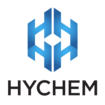Innovative solutions for manhole relining

Aging sewer infrastructure is a problem facing water authorities across Australia. Manhole deterioration is one of the many issues that needs to be addressed, with more and more emphasis being placed on rehabilitating these assets rather than rebuilding. To meet industry needs, Hychem have developed an innovative solution to make rehabilitation fast and affordable.
The manhole problem
Microbial induced corrosion (MIC) is a problem affecting the longevity of manholes and sewer structures.
MIC occurs when acidophilic bacteria in the sewer system feed on sulfur in hydrogen sulfate gas, releasing sulfuric acid which can corrode mortar, steel, ductile iron and concrete.
This is compounded when there are pre-existing problems caused by errors during the construction of a manhole.
Other factors that can influence the structural integrity of a manhole include soil movement from naturally occurring events such as earthquakes or induced by construction activities and traffic; and fluctuations in the water table.
Damaged or deteriorated manholes are a concern for water authorities as it can allow groundwater to enter the sewer network (infiltration), which places capacity strain on the system.
Through rehabilitation, infiltration from manholes can be reduced and sewage flows better managed, especially during storms and heavy rain events, protecting the health of the community and the environment.
A versatile solution
Epoxy liners are well suited to rehabilitating and relining manholes, and can transform deteriorated structures that have been badly sealed or corroded, and return them to a better-than-new condition.
Coating specialist Hychem developed its TL5 coating system in Australia, designed for use in environments where exposure to alkali and dilute mineral acids is required such as manholes.
The innovative coating has been used in the wastewater industry for over twenty years, and can rehabilitate a structure and stop corrosion damage with just one thick, spray applied coating.
According to Colin Murphy, product manager for Hychem, water authorities have been impressed by their ability to rehabilitate assets quickly and effectively with TL5.
“As TL5 is a one-coat solution, water authorities like the fact that their asset is back in service with minimal downtime. But more importantly, the product holds up well to the conditions present in the harsh sewer environment, and can last the distance. We have clients who have reported minimal change to the lining they had installed 15-20 years ago.
“Epoxy liners also have a smooth finish making them low-friction, and they can be applied in thicknesses as small as 2-3mm compared to other liners which can have thicknesses up to 30mm+.
“Furthermore, for manholes in high movement areas Hychem have adapted the TL5 formula to enhance its flex capabilities.”
Mr Murphy said the increased flex of Hychem’s TL5 IRF coating allows it to withstand greater levels of movement.
“TL5 IRF has a 40 per cent greater stretch capability than TL5 and is able to adapt to vibrations present within manholes that are close to main roads which have high levels of traffic.
“We have also been able to maintain the performance of the original TL5 coating.
“In order to improve flexibility, many coatings compromise the chemical resistance, durability and cure time of the product.
“However, with TL5 IRF we have been able to maintain very similar characteristics to the original TL5.”
For more information on Hychem’s products, visit www.hychem.com.au, or call (02) 4646 1660.
